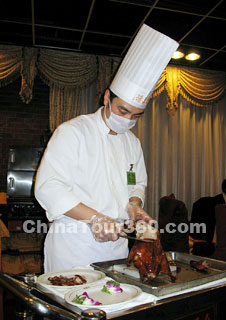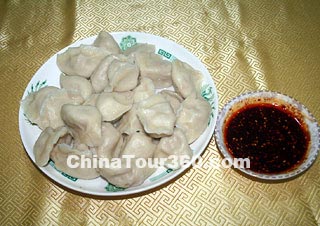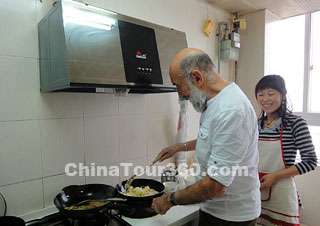
Beijing Roast Duck
Chinese cuisine has a long history that goes back nearly four to five thousand years. Its highly esteemed reputation in the world is due not only to its abundance and exquisiteness, but also to its delicious taste and charming appearance. With a diversity of climates, products and customs, Chinese cuisine has a great variety of food styles and tastes that reflect different regions locally.
![]() Chinese Food Features
Chinese Food Features
Chinese Cuisine is an integration of color, redolence, taste, shape, meaning and instruments. Meanwhile, the selection of the materials is so broad that almost all of the edible things on the earth can be cooked into delicate cuisines.
Most food materials are cut into small edible shapes before cooking, including slices, threads, blocks and grains. The same material should be cut into pieces of even size and thickness. Some materials can even be carved into fine patterns laid on the plate as decorations.
At the same time, various seasonings are necessary, such as sauce, lobster sauce, pepper, hot pepper, wild pepper, gourmet powder, vinegar, white sugar, liquor, ginger, garlic, sesame oil and green onion. With the help of these seasonings, Chinese cuisine present a great variety of tastes such as sour, sweet, bitter, hot, salty, spicy and hot, sour and hot, spiced, sweet and sour, fish-flavored and so on.
In addition, the colors of the main materials and the assisting materials must match and supplement each other. For instance, green vegetables, tomatoes, onions, leek and garlic sprout are often used to serve as a foil to the other materials in Chinese cuisine.
When everything is ready, the materials will be cooked through various cooking methods, including frying, boiling, stewing, braising, steaming, crisping, baking, and simmering. At last, the cooked food will be put in specific plates and dishes to perfect the masterpieces.
![]() Chinese Food Symbolism
Chinese Food Symbolism
In China, different foods have different meanings, and so there are specific foods for special occasions.

Chinese Dumplings (Jiaozi)
![]() Long noodle – longevity
Long noodle – longevity
![]() Egg - continuation of life
Egg - continuation of life
![]() Fish - a wealthier life
Fish - a wealthier life
![]() Dumplings - the end of the old year and the beginning of the new year
Dumplings - the end of the old year and the beginning of the new year
![]() Sweet dumplings (sugar-filled glutinous rice balls) - "Tang Yuan" or "Yuan Xiao" in Chinese, both of which have a "Yuan". In Chinese language, "Yuan" can also refer to "Tuan Yuan", meaning family reunions.
Sweet dumplings (sugar-filled glutinous rice balls) - "Tang Yuan" or "Yuan Xiao" in Chinese, both of which have a "Yuan". In Chinese language, "Yuan" can also refer to "Tuan Yuan", meaning family reunions.
![]() Date, peanut, longan and melon seeds - to have a lovely baby
Date, peanut, longan and melon seeds - to have a lovely baby
![]() Duck –fidelity
Duck –fidelity
![]() Chicken - in Chinese, it is "ji" and has the same pronunciation withthe character which means auspiciousness and luck.
Chicken - in Chinese, it is "ji" and has the same pronunciation withthe character which means auspiciousness and luck.
![]() Dried bean curd, black moss seaweed, peanuts, pomelos and oranges - good wishes
Dried bean curd, black moss seaweed, peanuts, pomelos and oranges - good wishes
![]() Table Manners
Table Manners
The traditional table manners are composed of a series of procedures. First, the host and hostess will invite their guests by sending invitations. Second, when the guests arrive, the host and hostess will welcome them in front of their house where they will greet each other warmly. Then they will bring their guests into the sitting room, allow them to be comfortable and sit, and then treat them with tea and desserts. When everyone has come, the host and hostess will invite their guests to sit at a table that has been arranged in specific order. The first seat on the left side is the top of the table, and the opposite one on the right side is the second seat. The seat next to it is the third, and so forth down the line. The most important and eldest guest usually will sit in the top seat, with others seated accordingly. After all of the guests have settled in, the host and
 |
| Learning Chinese Cooking |
When eating, one should allow the guests and the eldest to eat first. It is proper etiquette to pick up only a little bit of food at a time. If the food is out of reach, never stand to pick it up them. It is also not polite to make a lot of noise when eating, especially when drinking soup. Use your hand to put any bones you find onto your dishware or the paper napkins nearby. And do NOT pick your teeth at the table.
Further Reading: Eight Cuisines in China Chinese Chopsticks







